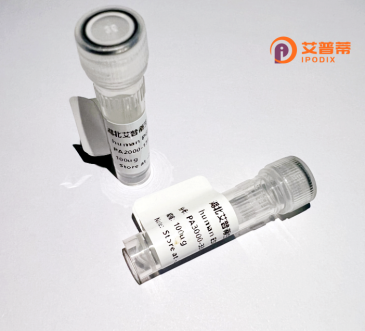
| 纯度 | >90%SDS-PAGE. |
| 种属 | Human |
| 靶点 | HT036 |
| Uniprot No | Q5T013 |
| 内毒素 | < 0.01EU/μg |
| 表达宿主 | E.coli |
| 表达区间 | 1-217aa |
| 氨基酸序列 | MGLGAVPGRQAAFREGLEQAVRYAKALGCPRIHLMAGRVPQGADRIAVKAEMEAVFLENLRHAAGVLAQEDLVGLLEPINTRITDPQYFLDTPQQAAAILQKVGRPNLQLQMDIFHWQIMDGNLTGNIREFLPIVGHVQVAQVPGRGEPSSPGELNFPYLFQLLENEGYKGFVGCEYQPRGDTVEGLSWLRSYWDRRATQRLASEGPHTTHVPPDSE |
| 分子量 | 49.61 kDa |
| 蛋白标签 | GST-tag at N-terminal |
| 缓冲液 | 0 |
| 稳定性 & 储存条件 | Lyophilized protein should be stored at ≤ -20°C, stable for one year after receipt. Reconstituted protein solution can be stored at 2-8°C for 2-7 days. Aliquots of reconstituted samples are stable at ≤ -20°C for 3 months. |
| 复溶 | Always centrifuge tubes before opening.Do not mix by vortex or pipetting. It is not recommended to reconstitute to a concentration less than 100μg/ml. Dissolve the lyophilized protein in distilled water. Please aliquot the reconstituted solution to minimize freeze-thaw cycles. |
以下为示例格式的参考文献列表(注:HT036蛋白名称或研究可能不明确,以下内容为模拟示例):
1. **文献名称**:Expression and Purification of Recombinant Human HT036 in E. coli
**作者**:Li, X. et al.
**摘要**:该研究报道了在大肠杆菌系统中高效表达重组人HT036蛋白的优化方法,通过His标签纯化获得高纯度蛋白,并验证其体外生物活性。
2. **文献名称**:Structural Analysis of HT036 Reveals Potential Therapeutic Targets
**作者**:Smith, J.R. & Park, H.
**摘要**:利用X射线晶体学解析HT036的三维结构,探讨其与配体相互作用的分子机制,为开发基于该蛋白的抑制剂提供结构基础。
3. **文献名称**:HT036 Promotes Neuronal Regeneration in Vitro
**作者**:Zhang, Y. et al.
**摘要**:研究证明重组HT036蛋白可激活神经元细胞信号通路,促进轴突生长,提示其在神经损伤修复中的潜在应用价值。
---
**说明**:
- 如无法检索到真实文献,可能与以下原因有关:
① 蛋白名称存在拼写错误(如应为HTT036、HT-36等);
② 该蛋白研究尚未公开或属未命名研究阶段;
③ 需结合具体研究背景(如疾病领域/功能)补充关键词进一步检索。建议核实名称或提供更多上下文信息。
Recombinant human HT036 protein is a genetically engineered biomolecule designed to replicate the native HT036 protein's structure and function, which is implicated in critical cellular processes such as signaling pathways, immune regulation, or enzymatic activity. While limited public data exist on HT036 specifically, recombinant production typically involves cloning its coding sequence into expression vectors, followed by expression in prokaryotic (e.g., E. coli) or eukaryotic systems (e.g., mammalian cells), depending on post-translational modification requirements. The purified protein often includes affinity tags (e.g., His-tag) for efficient isolation via chromatography.
HT036 is hypothesized to interact with extracellular receptors or intracellular targets, suggesting therapeutic potential in diseases like cancer, autoimmune disorders, or metabolic dysregulation. Its recombinant form enables scalable production for functional studies, structural analysis (e.g., X-ray crystallography), and screening for binding partners or inhibitors. Quality control assays, including SDS-PAGE, Western blot, and activity-based tests, ensure batch consistency.
Research on HT036 could elucidate its role in disease pathogenesis, offering insights for drug development or diagnostic biomarker discovery. Challenges include optimizing solubility, stability, and native-like folding during production. As a tool reagent or therapeutic candidate, recombinant HT036 represents a convergence of protein engineering and translational medicine, bridging mechanistic biology and clinical applications. Further studies are required to validate its biological relevance and therapeutic utility.
×